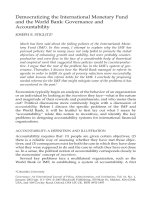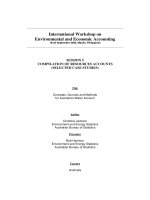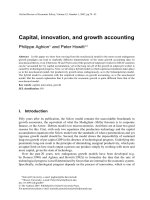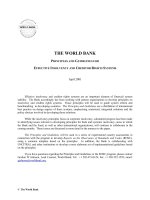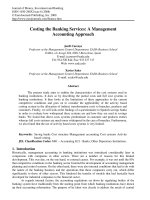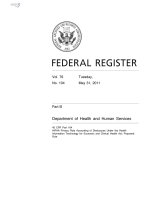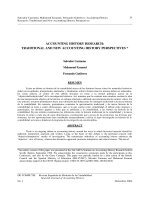JD Edwards World Product Costing and Manufacturing Accounting Guide potx
Bạn đang xem bản rút gọn của tài liệu. Xem và tải ngay bản đầy đủ của tài liệu tại đây (3.53 MB, 306 trang )
JD Edwards World
Product Costing and
Manufacturing Accounting
Guide
Version A9.1
Revised - April 30, 2008
JD Edwards World
Product Costing and Manufacturing Accounting Guide
Copyright © 2006, Oracle. All rights reserved.
The Programs (which include both the software and documentation) contain proprietary information; they are
provided under a license agreement containing restrictions on use and disclosure and are also protected by
copyright, patent, and other intellectual and industrial property laws. Reverse engineering, disassembly, or
decompilation of the Programs, except to the extent required to obtain interoperability with other independently
created software or as specified by law, is prohibited.
The information contained in this document is subject to change without notice. If you find any problems in the
documentation, please report them to us in writing. This document is not warranted to be error-free. Except as may
be expressly permitted in your license agreement for these Programs, no part of these Programs may be reproduced
or transmitted in any form or by any means, electronic or mechanical, for any purpose.
If the Programs are delivered to the United States Government or anyone licensing or using the Programs on behalf
of the United States Government, the following notice is applicable:
U.S. GOVERNMENT RIGHTS
Programs, software, databases, and related documentation and technical data delivered to U.S. Government
customers are “commercial computer software” or “commercial technical data” pursuant to the applicable Federal
Acquisition Regulation and agency-specific supplemental regulations. As such, use, duplication, disclosure,
modification, and adaptation of the Programs, including documentation and technical data, shall be subject to the
licensing restrictions set forth in the applicable Oracle license agreement, and, to the extent applicable, the additional
rights set forth in FAR 52.227-19, Commercial Computer Software Restricted Rights (June 1987). Oracle Corporation,
500 Oracle Parkway, Redwood City, CA 94065.
The Programs are not intended for use in any nuclear, aviation, mass transit, medical, or other inherently dangerous
applications. It shall be the licensee's responsibility to take all appropriate fail-safe, backup, redundancy and other
measures to ensure the safe use of such applications if the Programs are used for such purposes, and we disclaim
liability for any damages caused by such use of the Programs.
The Programs may provide links to Web sites and access to content, products, and services from third parties. Oracle
is not responsible for the availability of, or any content provided on, third-party Web sites. You bear all risks
associated with the use of such content. If you choose to purchase any products or services from a third party, the
relationship is directly between you and the third party. Oracle is not responsible for: (a) the quality of third-party
products or services; or (b) fulfilling any of the terms of the agreement with the third party, including delivery of
products or services and warranty obligations related to purchased products or services. Oracle is not responsible for
any loss or damage of any sort that you may incur from dealing with any third party.
Oracle, JD Edwards, PeopleSoft, and Retek are registered trademarks of Oracle Corporation and/or its affiliates.
Other names may be trademarks of their respective owners.
Open Source Disclosure
Oracle takes no responsibility for its use or distribution of any open source or shareware software or documentation
and disclaims any and all liability or damages resulting from use of said software or documentation. The following
open source software may be used in Oracle's PeopleSoft products and the following disclaimers are provided.
This product includes software developed by the Apache Software Foundation (
Copyright (c) 1999-2000 by The Apache Software Foundation. All rights reserved. THIS SOFTWARE IS PROVIDED
“AS IS’’ AND ANY EXPRESSED OR IMPLIED WARRANTIES, INCLUDING, BUT NOT LIMITED TO, THE
IMPLIED WARRANTIES OF MERCHANTABILITY AND FITNESS FOR A PARTICULAR PURPOSE ARE
DISCLAIMED. IN NO EVENT SHALL THE APACHE SOFTWARE FOUNDATION OR ITS CONTRIBUTORS BE
LIABLE FOR ANY DIRECT, INDIRECT, INCIDENTAL, SPECIAL, EXEMPLARY, OR CONSEQUENTIAL
DAMAGES (INCLUDING, BUT NOT LIMITED TO, PROCUREMENT OF SUBSTITUTE GOODS OR SERVICES;
LOSS OF USE, DATA, OR PROFITS; OR BUSINESS INTERRUPTION) HOWEVER CAUSED AND ON ANY
THEORY OF LIABILITY, WHETHER IN CONTRACT, STRICT LIABILITY, OR TORT (INCLUDING NEGLIGENCE
OR OTHERWISE) ARISING IN ANY WAY OUT OF THE USE OF THIS SOFTWARE, EVEN IF ADVISED OF THE
POSSIBILITY OF SUCH DAMAGE.
Product Costing and Manufacturing Accounting Guide (Revised – April 30, 2008)
Send Us Your Comments
JD Edwards World Release A9.1 Documentation, Revised - April 30, 2008
JD Edwards World welcomes your comments and suggestions on the quality and
usefulness of this publication. Your input is an important part of the information
used for revision.
Did you find any errors?
Is the information clearly presented?
Do you need more information? If so, where?
Are the examples correct? Do you need more examples?
What features did you like most about this manual?
If you find any errors or have any other suggestions for improvement, please
indicate the title and part number of the documentation and the chapter, section,
and page number (if available). You can send comments to us by e-mail at:
If you would like a reply, please give your name, address, telephone number,
and electronic mail address (optional).
Contact a JD Edwards World representative by calling Oracle Global Support
Center at 1-800-289-2999 for current information or if you have any questions
regarding this document.
Send Us Your Comments
JD Edwards World, A9.1
Contents
1 Overview
Overview to Product Costing and Manufacturing Accounting 1-1
System Integration 1-1
Features 1-2
Product Costing and Manufacturing Accounting Integration 1-3
Achieving Effective Cost Management 1-7
Tables 1-8
Menu Overview 1-10
2 Product Costing
Overview to Product Costing 2-1
About Product Costing 2-1
Set Up Product Costing 2-5
Setting Up Product Costing 2-5
Setting Up Accounting Cost Quantities 2-5
Setting Up Item Cost Levels 2-6
Converting Item Cost Levels 2-10
Setting Up Item Costs 2-11
Setting Up Cost Components 2-16
Setting Up Manufacturing Constants for Product Costing 2-17
Setting Up Simulated Rates for a Work Center 2-21
Setting Up Actual Rates for a Work Center and Overhead 2-23
Review Bills of Material and Routings 2-25
Reviewing Bills of Material and Routings for Product Costing 2-25
Reviewing Product Costing in Bills of Material 2-25
Reviewing Routings for Product Costing 2-30
Create Simulated Costs 2-35
Creating Simulated Costs 2-35
Creating the Costing Exceptions Report 2-36
Creating a Simulated Rollup 2-38
Product Costing and Manufacturing Accounting Guide (Revised - April 30, 2008) i
Contents
Work with Simulated Cost Components 2-41
Working with Simulated Cost Components 2-41
Reviewing and Revising Simulated Cost Components 2-41
Setting Up Standard Rate and Factor Codes 2-45
Assigning Values to User Defined Cost Components 2-47
Reviewing the Standard Cost Simulation Report 2-50
Setting Up Cost Bucket Codes for Costed Bills of Material 2-50
Reviewing Costed Bills of Material 2-52
Setting Up Operation Bucket Codes for Costed Routings 2-60
Reviewing a Costed Routing 2-61
Update Frozen Costs 2-67
Updating Frozen Costs 2-67
Review Costing Information 2-73
Reviewing Costing Information 2-73
Reviewing Frozen Cost Components 2-73
Reviewing the Item Ledger 2-75
Reviewing the Single Level Costed Bill of Material Report 2-78
Reviewing the Multi-Level Costed Bill of Material Report 2-79
Reviewing the Cost Components Report 2-80
Reviewing the Cost Integrity Report 2-81
Work with Additional Costing Features 2-83
Working with Additional Costing Features 2-83
Copying Costs 2-83
Copying Frozen Costs to Simulated Costs 2-84
Updating Sales Order Price/Cost 2-84
Updating Product Costs 2-84
3 Product Costing in ERPx Environments
Overview to Product Costing in ERPx Environments 3-1
About Product Costing in ERPx Environments 3-1
Understand Batch Product Costing 3-3
About Batch Product Costing 3-3
Understand Product Costing for Planning Items 3-5
About Product Costing for Planning Items 3-5
Work with Process Industry Costing 3-7
Working with Process Industry Costing 3-7
JD Edwards World, A9.1 ii
Contents
Reviewing Product Costing for Processes 3-9
Reviewing Product Costing for Intermediates 3-11
Reviewing Product Costing for Ingredients 3-13
Reviewing Product Costing for Co- and By-Products 3-14
Calculating Costs for Co- and By-Products 3-19
Reviewing Product Costing for Percent Bills of Material 3-28
Understand Configured Items 3-31
About Costing for Configured Items 3-31
4 Manufacturing Accounting
Overview to Manufacturing Accounting 4-1
About Manufacturing Accounting 4-1
Set Up Manufacturing Accounting 4-15
Setting Up Manufacturing Accounting 4-15
Setting Up General Ledger (G/L) Class Codes 4-15
Reviewing Manufacturing AAIs 4-17
Work with Work Orders 4-25
Working with Work Orders 4-25
Creating a Work Order (P48013) 4-25
Attaching a Parts List and Routing Instructions 4-28
Issuing Parts to Work Orders 4-29
Recording Hours and Quantities Used 4-31
Recording Component Scrap 4-34
Recording Completions to Work Orders 4-37
Create Journal Entries 4-41
Creating Journal Entries 4-41
Creating Journal Entries for Work in Process or Completions 4-44
Reviewing Variances (P3102) 4-47
Creating Journal Entries for Variances 4-52
Creating Journal Entries for Bulk Manufacturing Gains and Losses 4-56
Reviewing Summarized Work Order Journal Entry Batches 4-57
Review General Ledger Batches 4-59
Reviewing General Ledger Batches 4-59
Post to the General Ledger 4-69
Posting to the General Ledger 4-69
Posting Manufacturing Journal Entries 4-69
Product Costing and Manufacturing Accounting Guide (Revised - April 30, 2008) iii
Contents
Reviewing the Posting Edit Report for Manufacturing 4-72
Reviewing the Posting Journal Report 4-73
Reviewing the Item Ledger/Account Integrity Report 4-74
Reviewing World Writer Reports for Manufacturing Accounting 4-76
5 Manufacturing Accounting in ERPx Environments
Overview to Manufacturing Accounting in ERPx Environments 5-1
About Manufacturing Accounting in ERPx Environments 5-1
Understand Process Industry Accounting 5-3
About Process Industry Accounting 5-3
6 Processing Options
Product Costing Processing Options 6-1
Item Cost Level Conversion - Final (P41815) 6-1
Item Cost Revisions (P4105) 6-1
Costing Exceptions (P30801) 6-2
Cost Simulation (P30820) 6-2
Item Cost Components (P30026) 6-4
Costed Bill of Material Inquiry (P30206) 6-4
Costed Routing Inquiry (P30208) 6-5
Item Cost Update (P30835) 6-6
Item Ledger - Costs (P4111) 6-7
Costed Bill (P30440) 6-8
Multi-Level Costed Bill (P30445) 6-9
Cost Components (P30026P) 6-10
Cost Component/Ledger Integrity (P30543) 6-10
Copy Component Cost Values (P30890) 6-10
Cost Simulation Reset (P30850) 6-11
Update Sales Cost, Price, or Exchange Rate (P42950) 6-11
Item Cost Revisions (P4105) 6-13
Product Costing in ERPx Environments Processing Options 6-15
Costed Routing Inquiry (P30208) 6-15
Manufacturing Accounting Processing Options 6-17
AAI Revisions (P40901) 6-17
Generate and Print Work Orders (P31410) 6-17
Component Scrap Transactions (P31116) 6-22
Manufacturing WIP Journal Entries (P31802) 6-23
Manufacturing Variance Journal Entries (P31804) 6-24
JD Edwards World, A9.1 iv
Contents
Work Order Closing and Clear WIP (P31806) 6-25
Gain/Loss Analysis Report (P415402) 6-26
General Ledger Post (P09800) 6-27
Item Ledger/Account Integrity (P41543) 6-30
7 Appendices
Appendix A – Calculations in Cost Rollup 7-1
Material Cost Components 7-1
Routing Cost Components 7-2
Outside Operation Cost Components (Usually Dx) 7-3
Appendix B – Calculations for Variances 7-7
Standard Costs 7-7
Current Costs 7-7
Planned Costs 7-8
Actual Costs 7-8
Completed/Scrapped Costs 7-9
Appendix C – Purchase Price Variance 7-11
Example: Purchase Price Variance and Material Burden 7-11
Appendix D – Functional Servers 7-13
About Functional Servers 7-13
Appendix E – Files and Fields Updated 7-15
Appendix F – Troubleshooting Techniques for Product Costing 7-17
Run the Integrity Analysis Program (P30601) 7-17
Verify the Processing Options for P30820 7-17
Review A1 Cost Setup 7-18
Review Batch Quantity Setup 7-18
Adjust Primary Unit of Measure 7-18
Adjust the B1 or B2 Costs 7-18
Adjust the B3 through C4 Costs 7-19
Adjust the D1, D2, D3 Costs 7-19
Appendix G – Routing Cost Type Calculations 7-21
B1 Direct Labor 7-21
B2 Setup Labor
7-21
B3 Machine Run 7-21
B4 Labor Efficiency Cost 7-21
C1 Machine (Mach) Variable (Var) Overhead (O/H) Cost 7-22
C2 Machine Fixed Overhead Cost 7-22
Product Costing and Manufacturing Accounting Guide (Revised - April 30, 2008) v
Contents
C3 Labor Variable Overhead 7-23
C4 Labor Fixed Overhead 7-23
JD Edwards World, A9.1 vi
1 Overview
Overview to Product Costing and
Manufacturing Accounting
Maintaining accurate and complete records on the value of inventory is one of the
major concerns of most businesses today. Keeping too much of an unprofitable
stock, or using inappropriate methods of costing certain inventory items, can
quickly deplete your profits.
The Product Costing system allows you to store and retrieve cost information. It also
helps you to manage your costs by providing informational inputs to your
company’s business plan. With accurate product costing, you can evaluate the
following manufacturing processes to determine the impact to your company’s
bottom line:
Manufacturing budgets (direct labor, indirect labor, and overhead)
Product design (design and manufacturing engineering)
Accounting (gross margin by product line or item)
After you establish costs in the Product Costing system, the Manufacturing
Accounting system tracks the costs, reports on variances, and posts manufacturing
transactions to the general ledger.
Note: The term work order is used throughout this guide. In general,
however, transactions that affect work orders also affect rate schedules.
System Integration
Product Costing and Manufacturing Accounting are two of the systems that are
included in the Enterprise Requirements Planning and Execution (ERPx) system.
ERPx is a closed-loop manufacturing system that formalizes company and
operations planning, and the implementation of those plans. Use the ERPx system to
coordinate your inventory and labor resources to deliver products according to a
managed schedule.
The following diagram shows the systems that make up ERPx and the sequence in
which they are implemented.
Product Costing and Manufacturing Accounting Guide (Revised - April 30, 2008) 1-1
Overview to Product Costing and Manufacturing Accounting
Features
The Product Costing and Manufacturing Accounting systems provide flexibility to
accommodate your manufacturing environment. Some of the benefits and features
of these systems are:
JD Edwards World, A9.1 1-2
Overview to Product Costing and Manufacturing Accounting
Feature Description
User defined cost add-ons
Define and maintain an unlimited number of cost
components for tracking specific costs, such as freight,
taxes, duty, and electricity.
User defined cost rollup
methods
Define an unlimited number of cost methods to use in cost
simulation analyses.
User defined cost factors
and rates
Allocate cost factors and rates to a specific item. Used with
cost add-ons to calculate additional costs.
Cost variances
Print a complete set of reports to compare old costs with
new costs before implementing any changes.
Bill of material rollup
Calculate the total material cost by retrieving the bill of
material for all items and adding the total cost of the
components.
Cost simulation
Run a complete simulation of costs before any live data is
updated as the frozen standard.
Multi-facility costing
Maintain cost information at the branch/plant level to allow
for cost variances at different locations for identical
manufactured items.
Variances Review four kinds of variances:
Engineering
Planned
Actual (material and labor)
Other
Journal entries for
variances
Create detailed or summary journal entries for work order
variances.
Journal entries for work
order transactions
Create detailed or summary journal entries for work in
process or completions.
Automatic accounting
instruction (AAI) tables
Charge dollar amounts to specified accounts.
Reports
Print reports listing detailed costs and variances for work
orders.
Product Costing and Manufacturing Accounting Integration
Product costing plays a significant role in the manufacturing environment. Before
you can implement your Manufacturing Accounting system, you must decide
between using either standard cost or actual cost methodology by branch plant. If
you choose standard cost methodology, set up frozen standard cost component
values for the products you produce. If you choose actual cost methodology, then
set up raw material and work center costs, not cost components. To calculate
Product Costing and Manufacturing Accounting Guide (Revised - April 30, 2008) 1-3
Overview to Product Costing and Manufacturing Accounting
standard cost component values, you must consider the following aspects in the
manufacturing environment:
Cost reporting (What does the item really cost to produce?)
Variance reporting (actual versus standard costs)
Product and job costing (detailed information)
Materials
Labor
Overhead
After you calculate your cost component values in a simulated mode and are
satisfied with the results, you must establish frozen standard cost components. If
you choose standard cost methodology, then all shop floor transactions use these
frozen standards for calculations, which, in turn, create transactions in your general
ledger and are the basis of your inventory valuation. If you choose actual cost
methodology, then shop floor transaction costs are calculated as they occur. For
actual cost, simulation and frozen cost components are not established.
Certain functions within the Product Costing and Manufacturing Accounting
systems overlap with other Manufacturing and Distribution systems, such as
Product Data Management and Shop Floor Control. Therefore, it is important that
you have a basic understanding of the following tables and how they interact with
other systems:
Item Master (F4101)
Manufacturing Data (F4102)
Branch/Plant Master (F4102)
Bill of Material Master (F3002)
Routing Master (F3003)
Work Center Master (F30006)
The following illustration demonstrates the interaction of tables within the Product
Costing and Manufacturing Accounting systems.
JD Edwards World, A9.1 1-4
Overview to Product Costing and Manufacturing Accounting
Product Costing and Manufacturing Accounting Guide (Revised - April 30, 2008) 1-5
Overview to Product Costing and Manufacturing Accounting
JD Edwards World, A9.1 1-6
Overview to Product Costing and Manufacturing Accounting
Achieving Effective Cost Management
Most of the major areas or departments within your manufacturing company
contribute information to your product costing activities and, therefore, affect the
overall accuracy of your manufacturing budget.
The following table lists examples of departments within your company and the
aspects of the Product Costing system which are affected by that department.
Department Description
Design Engineering
The Design Engineering group is responsible for ensuring
that:
The bill of material is complete
The make-buy information is accurate
The engineering change orders (ECOs) have been taken
into account
Sales
The Sales force contributes important information regarding
target markets, as well as the latest trends in
manufacturing. For effective cost management, it is
important that your sales force provide timely and
reasonable forecasts.
Manufacturing The Manufacturing Engineering group is responsible for
Engineering identifying:
Correct processes
Changes to existing processes
Manufacturing overhead
Accurate information about work centers
Purchasing The Purchasing department must provide:
Accurate supplier costs
Accurate transportation costs
Manufacturing Operations
Manufacturing Operations provides vital information to the
product costing effort. For example:
Input transaction data in a timely and accurate manner
Identify any discrepancies in the bills of material and
routings
Accounting The Accounting staff must:
Ensure that all items have costs
Identify general and administrative overhead
Produce timely variance reports (standard costs versus
current costs)
Several other issues should be considered as you define and manage your
manufacturing costs, including:
Product Costing and Manufacturing Accounting Guide (Revised - April 30, 2008) 1-7
Overview to Product Costing and Manufacturing Accounting
When (and how often) do you change standard costs?
How do you limit access to those authorized to change standard costs?
When are new items reflected in the standard?
How do you account for labor rates and work center overhead?
You might also encounter these typical circumstances as you define costs and
perform rollups:
Not all standards are available before your initial cost rollup.
You have used incorrect units of measure.
Your company inaccurately reports labor hours and costs.
New products are not updated in a timely manner.
Standards are updated too frequently.
Items have been added to or deleted from the bill of material since the last cost
update.
Steps in the routing master have been changed since the last cost update.
Tables
Table Description
Cost Components (F30026)
Contains all cost methods and cost components for each
method for all items. The exception to this is the weighted
average cost method 02, which is used for the actual cost
methodology.
Cost Ledger (F4105) Contains the costs of all items.
Manufacturing Constants
(F3009)
Stores variables that indicate whether Standard or Actual
costs are used and whether to include efficiency and
overhead in the cost.
Manufacturing Data
(F4102)
Stores the accounting cost quantity, which the system uses
to determine the allocation of fixed setup and material costs
for an item.
Routing Master (F3003)
Stores routing information, including operation sequence,
work center, run time, setup time, and machine time. The
system uses this information to calculate labor, machine,
and overhead costs.
Bill of Material Master
(F3002)
Contains information at the business unit level about bills of
material, such as quantities of components. The system uses
this information to calculate material costs.
Work Center Rates
(F30008)
Contains all rates for each work center, such as overhead
and labor.
Work Center Master
(F30006)
Contains detailed data about all defined work centers,
including efficiency.
JD Edwards World, A9.1 1-8
Overview to Product Costing and Manufacturing Accounting
Table Description
Item Ledger (F4111)
Contains IB transactions that indicate changes in inventory
value.
Account Master (F0901)
Contains account definitions, including numbers and
descriptions.
Account Ledger (F0911) Contains detailed transactions in the general ledger.
Account Balances (F0902)
Contains net postings for each period and prior year
balances (net and cumulative). There is one record per
account, ledger type, subledger, fiscal year, and transaction
currency table.
User Defined Codes
(F0005)
Contains user defined codes and their descriptions. User
defined codes in product costing and manufacturing
accounting include:
Cost methods (40/CM)
Cost components (30/CA)
Cost buckets (30/CB)
Operation buckets (30/CO)
Standard Rate and Factor
Codes (F00191)
Contains user-defined rate and factor codes that the system
uses in conjunction with the Rate Code and Rate Amount
fields to calculate extra costs (electricity, taxes, tooling
changes, and so on).
To access this table from the P30026 Manufacturing Cost
Components screen, select the F21 function key.
Batch Control (F0011)
Contains system-generated batch header information,
including the batch number, batch status, and batch entry
date.
Automatic Accounting
Instruction (AAI) Values
(F4095)
Contains account numbers that are used to create journal
entries and charge dollars to those accounts.
Work Order Master
(F4801)
Contains all work order header information. The data from
this table appears on shop floor paperwork. The system
updates this table when completion transactions occur
against a work order.
Work Order Master Tag
(F4801T)
Contains cost ledger information. The data from this table
indicates whether standard or actual cost accounting is
executed.
Parts List (F3111)
Contains the parts list that is attached to a work order. It
contains one record for each part. The system creates this
table interactively or when you run the Order Processing
program.
Work Order Time
Transactions (F31122)
Contains detail records of reported routing transaction
activity.
Product Costing and Manufacturing Accounting Guide (Revised - April 30, 2008) 1-9
Overview to Product Costing and Manufacturing Accounting
Table Description
Routing Instructions
(F3112)
Contains the routing steps that are attached to a work
order. It contains one record for each operation sequence
number and work center. The system creates this table
interactively or when you run the Order Processing
program.
Work Order Variances
(F3102)
Contains the amounts used for work order variance
calculations. The Order Processing program or interactive
attachment initially updates this table followed by the
Journal Entries for Manufacturing Accounting program.
Item Master (F4101)
Stores basic information about each defined inventory item,
such as item numbers, descriptions, category codes, and
units of measure.
Branch/Plant Master
(F4102)
Defines and maintains warehouse or plant level
information, such as branch level category codes.
Address Book (F0101)
Contains a variety of information, including information
about customers, suppliers, employees, and prospects.
Business Unit Master
(F0006)
Identifies information about business units, such as
company names and category codes assigned to the
business unit.
Cost Ledger (F4105)
Contains total costs for each cost method and level for all
inventory items. Defines the Sales/Inventory and
Purchasing cost method for each item.
Menu Overview
JD Edwards World systems are menu-driven. Menus are organized according to
function and frequency of use.
Product Costing
Access Product Costing functions from the Product Data Management menus.
JD Edwards World, A9.1 1-10
Overview to Product Costing and Manufacturing Accounting
Fast Path Commands
The following table illustrates the fast path commands you can use to move among
the Product Costing menus.
Command Menu Title
DPC
PPC
SPC
G3014
G3023
G3042
Daily Product Costing
Periodic Product Costing
Product Costing Setup
Manufacturing Accounting
Access Manufacturing Accounting functions from the Shop Floor Control menus.
Manufacturing Systems G3
Shop Floor Control G31
Daily Processes
* Daily Manufacturing Accounting G3116
Periodic Processes
* Periodic Manufacturing Accounting G3123
Setup Processes
* Shop Floor Control Setup G3141
Product Costing and Manufacturing Accounting Guide (Revised - April 30, 2008) 1-11
Overview to Product Costing and Manufacturing Accounting
Fast Path Commands
The following table illustrates the fast path commands you can use to move among
the Manufacturing Accounting menus.
Command Menu Title
MA
PMA
SSFC
G3116
G3123
G3141
Daily Manufacturing Accounting
Periodic Manufacturing Accounting
Shop Floor Control Setup
JD Edwards World, A9.1 1-12
2 Product Costing

